BY BRIGITTE TREUMANN
I had actually planned to write a summer Perennial Biker story and, in preparation, had visited several outstanding garden walks in Ravenswoold Manor, the Bowmanville neighborhood where I made good friends from last year’s visit, and the glorious East Edgewater Glen Garden Walk. As always, I am most impressed with what ingenuity, devotion, good taste and joy these often small urban spaces are turned into jewels of floral abundance, oases of ferns, blooming bushes and romantic water features.

Garden in East Edgewater Glen, Chicago.
However lovely, my big summer story this year was traveling first to Munich to be part of many entertaining familial meetings, Kaffeeklatschs (informal social gatherings where coffeeis served), ice cream orgies, bretzel-munching, and sightseeing extravaganzas. My granddaughters Hazel and Hope and, of course, their parents ferried about to meet far flung German cousins, nephew, nieces, and a jolly great-uncle in his idyllic Upper Bavarian retreat. Slight language barriers notwithstanding, it was an exciting and merry experience eating under spreading chestnut trees, swimming in alpine lakes, visiting the fairy-tale castle Neuschwanstein, and retracing the von Trapp family’s life in Salzburg. I do hope the girls will have sweet memories of meeting their European family and the fun they had on their first big trip abroad.

Munich icons: the Glockenspiel tower, the Frauenkirche domes and St.Mary’s Column.

A jolly threesome: Dad and his daughters at the Auer Dult, a typical Munich neighborhood fair.
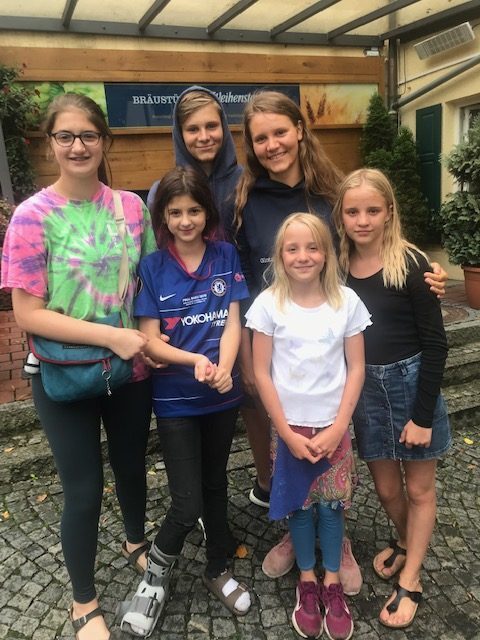
Gathering of cousins.

Sweet last evening in Munich.
I continued my chevauchée (stately progress on horseback), though on less romantic but more comfortable trains, to the pleasant university town of Freiburg in Germany’s south-west Black Forest where I met with dear friends and reunited with my adventuresome and widely-traveled cousin Friederike. She and I indulged, besides chatting until the wee hours, in happy sightseeing, the superb wines, fruit spirits, and Michelin-starred foods of the Markgräflerland (Margraves’ Land), so named after the Margraves of Baden who had ruled this region in the High Black Forest for many centuries. Close to Freiburg the ancient town of Staufen, with its namesake castle ruin among vineyards, perched high above the valley, purports to be the very place where Mephistopheles made an end to the life of the famous/infamous Dr. Faust, yes, that Dr. Faust of Goethe fame. The city remembers this dramatic event not only with annual open-air stagings of the play, but also by naming a street and businesses, such as a pharmacy, after the tortured hero Heinrich Faust. When I researched this charming place after my return, I learnt that the medieval aspect of the place is a faithful reconstruction of the ancient place that was mostly destroyed at the end of World War II. I obviously did not realize this but, like a sweet American tourist, I oohed and aahed at the seemingly medieval architecture. Reconstruction or not, Staufen is charming and my cousin and I had a fine meal in one of the many Weinrestaurants.

Historic marker relating the Faust story.

Staufen castle.
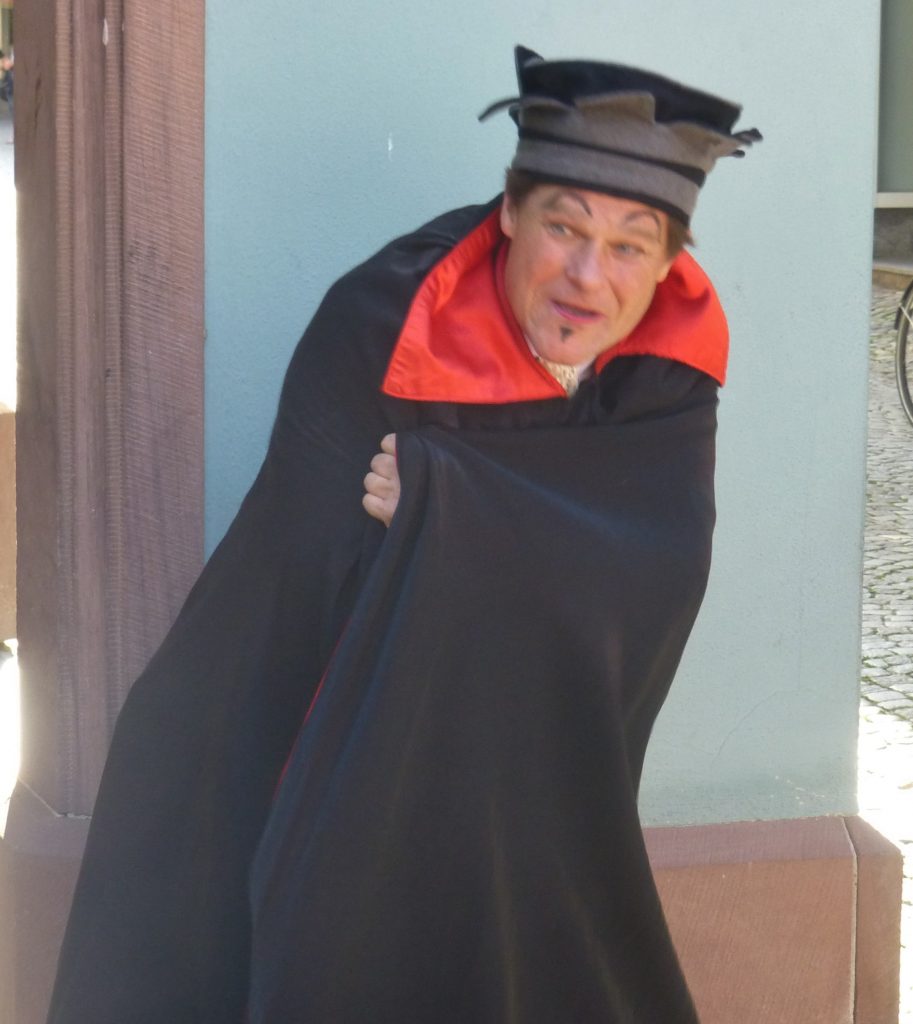
Mephistopheles, scaring the unsuspecting tourist.

Faust Pharmacy.

Schladerer distillery, world-famous for its fruit spirits, such as the very aromatic Kirschwasser, or cherry brandy.
In nearby Breisach on the Rhine river, I was very touched by the modest, but elegant romanesque St. Stephan Münster (cathedral, church). Like Staufen, Breisach and the Münster were heavily damaged during the last months of World War II as the Allies crossed the Rhine. Happily, much of the town and especially the cathedral could be saved and rebuilt.

The Münster.
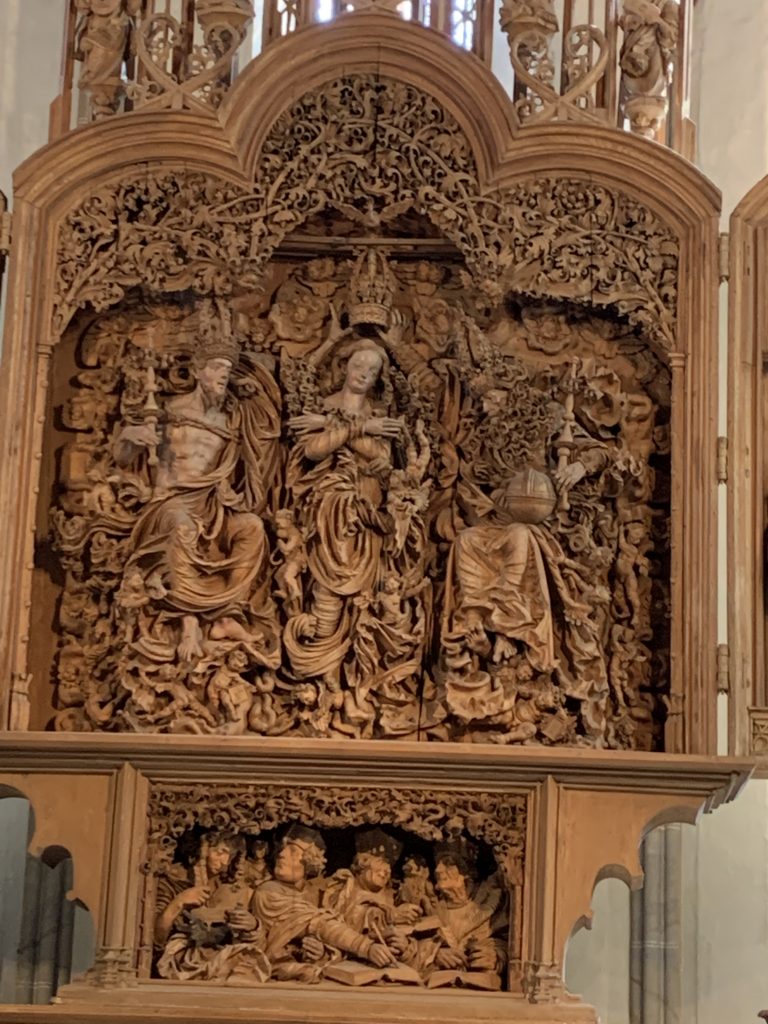
The stunning high-altar piece or retablo was carved by master wood carver HL (we only have the initials) ca. 1526.
The church is also famous for its much-restored frescoes, depicting a fantastically dramatic presentation of the Last Judgment by Martin Schongauer (1445-1491), also known as Martin Schön (Martin Beautiful). Besides being a highly accomplished painter, he is said to have been among the most important print makers of his time.
Our splendid meanderings between Freiburg and Basel, a distance of about 70 km , also included excellent contemporary art and architecture. I was particularly interested in the Museum – Foundation Beyeler, just outside of Basel. A stunning building by Renzo Piano, set in a superbly landscaped park, houses the private collection of art dealers Ernst and Hildy Beyeler. The collection represents primarily the evolution of classic modernism ranging from works by Claude Monet, Paul Cezanne, Vincent Van Gogh to 23 Picasso pieces, Roy Lichtenstein and Francis Bacon. From there we backtracked home, stopping at Vitra architecture campus/park in Weil on the Rhine, created by the Swiss home and office furniture firm Vitra. To quote the eminent architect Philip Johnson “not since the Weissenhofsiedlung in Stuttgart in 1927 has there been a gathering in a single place of a group of buildings designed by the most distinguished architects in the Western World.” My photographs do in no way justice to those amazing creations, though there is a certain atmospheric drama to them: black, scudding clouds of an impending thunderstorm are a phenomenal background to Frank Gehry’s stark white museum building and Renzo Piano’s glassy “warehouses” looming precipitously above the ground. Marvelous indeed!
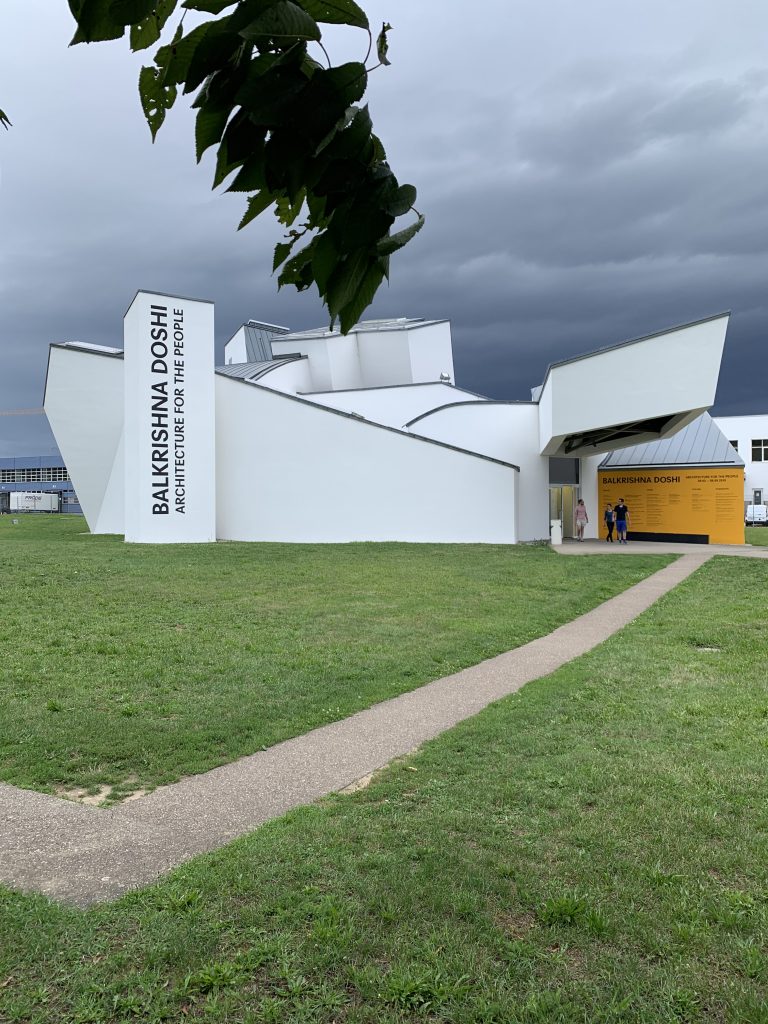
Frank Gehry the museum in Vitra architecture park.
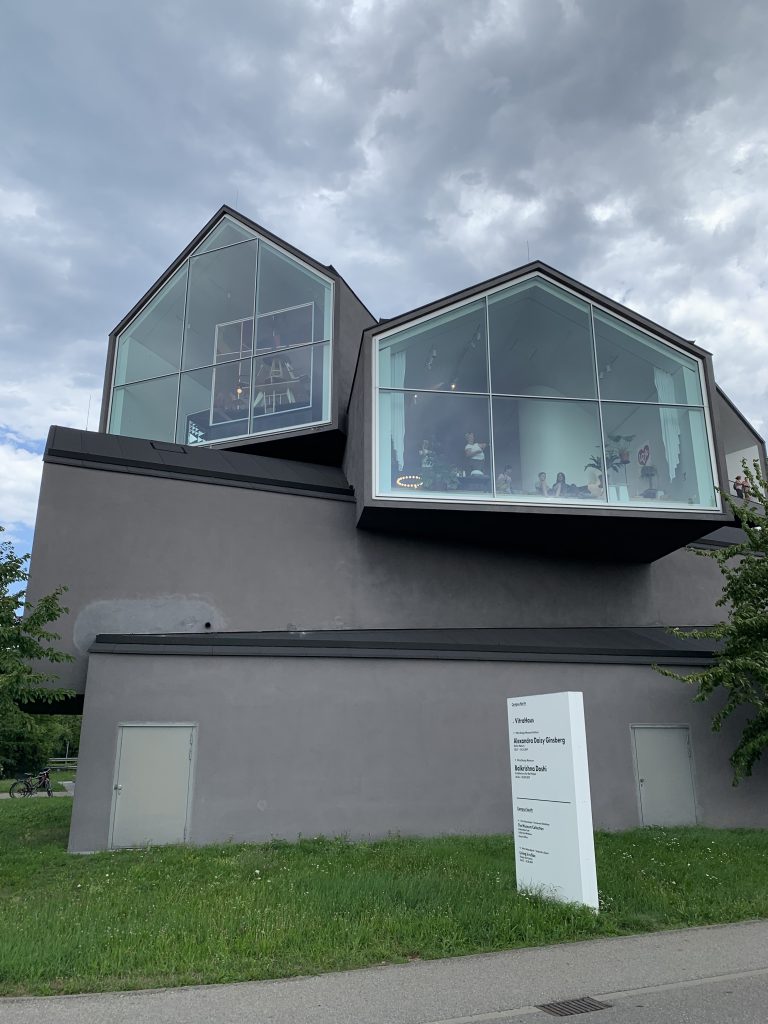
Renzo Piano the warehouse structures in Vitra architecture park.
It was time to continue my “promenade” and head towards my next station in what a French friend called “cousinage.” (meeting of cousins). They, cousins Rose, Bettina and Wilhelm, waited at the Gare de Lyon to take me to their “maison de campagne” (country house) in Lèves, a small community just beyond Chartres. We have all known each other forever and so it was a very jolly get-together in their spacious, elegant and welcoming abode surrounded by grand old trees, an extensive lawn and a very romantic fishpond. The pond’s focal point and great attraction is a bronze female statue, I call her La Dame de Leves, who once graced a fancy family burial in a vanished Berlin cemetery and now, re-purposed, watches over smartly darting gold fish and a lovely clump of waterlilies.

La Dame de Lèves.
We often drove into the pleasant town of Chartres, mostly to marvel at and pay obeisance to the magnificent, intensely stirring cathedral of cathedrals. I had been there once before but had forgotten the splendor of its dimensions, the glorious windows, the sheer energy of the space. I was struck by the powerful statuary adorning the cathedral’s portals, those sternfaced representations of saints, biblical and royal figures. Chief among them the royal couple, Eleanor of Aquitaine and her first husband, Louis VII, King of France.
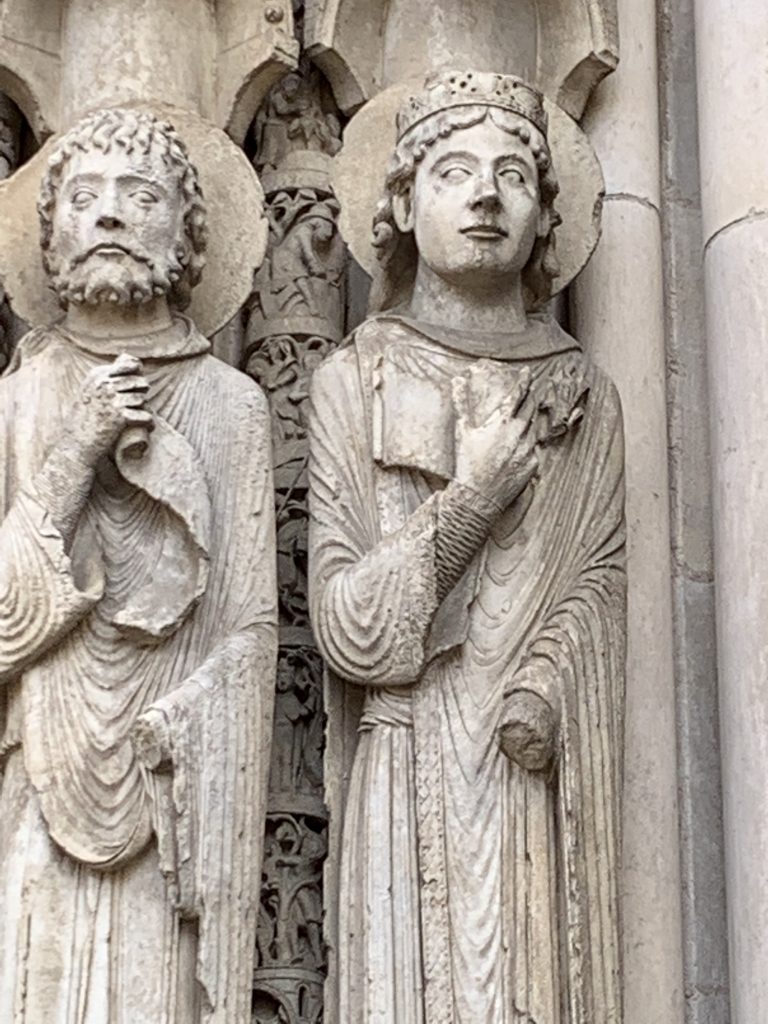
Eleanor of Aquitaine (1137 – 1204) and her first husband, Louis VII, King of France (1120 – 1180)

Glorious Chartres Cathedral.

Fabulous statuary.

Windows and light.
Another enchanting excursion took us to the chateaux of Blois with its grand external staircase and the more intimate Chenonceau. There I particularly liked the landscape, the situation of the building constructed across the confluence of the rivers Cher and Loire.

The fabulous Renaissance staircase at Blois, reign of François I of France, 1494 – 1547
On our last day together, we decided to have a rencontre with the childhood haunts of Marcel Proust (1871 – 1922) in nearby Illiers-Combray. The house of “Tante Léonie” has been transformed into a charming museum to the writer’s memory, a pleasant, cozy 19 th century home with wonderful Proustian memorabilia and photographs of his contemporaries that in one form or another appear in his novels. Much has been made of the evocative power of a small cake called madeleine (madeleines can be found in practically every sweet/chocolate shop in the area, not only in Illiers-Combray) and I, too, feel
compelled to quote the famous passage from “Remembrance of Things Past, “I raised to my lips a spoonful of the tea in which I had soaked a morsel of the cake. No sooner had the warmth of the liquid mixed with the crumbs touched my palate than a shudder ran through me and I stopped, intent upon the extraordinary thing that had happened to me. An exquisite pleasure had invaded my senses.” We, of course, went to a local tea shop and ordered the linden-blossom tea and sweet little madeleines. While they did not have quite the dramatic Proustian effect, it was a lovely coda to our “cousinage” and my remarkable summer trip.

The house of “Tante Léonie” at Illiers-Combray.

Modernist portrait of Marcel Proust.

Cousins reading “A La Récherche Des Temps Perdus” in Tante Léonie’s garden.

Lindenblossom tea and madeleines.







